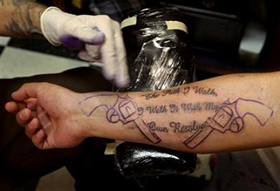 |
 |
 |
 Editorials | At Issue | March 2006 Editorials | At Issue | March 2006  
Army Relaxes Tattoo Rules to Attract Recruits
 Will Dunham - Reuters Will Dunham - Reuters


| | A tattoo artist works to apply a tattoo to the forearm of a National Guardsman at the Crescent City Tattoo Parlor in New Orleans, Louisiana October 18, 2005. The U.S. Army, which missed its recruiting goal last year, has relaxed its policy banning certain types of tattoos in a bid to attract new soldiers who otherwise would have been barred from serving. (Lucas Jackson/Reuters) |
The U.S. Army, which missed its recruiting goal last year, has relaxed its policy banning certain types of tattoos in a bid to attract new soldiers who otherwise would have been barred from serving.

The Army will now allow new recruits and all its current soldiers to have tattoos on their hands and back of their necks as long as they are not "extremist, indecent, sexist or racist," Army officials said on Wednesday.

The Army said it continues to prohibit tattoos anywhere on the head, face or throat area.

But it will allow women recruits and soldiers to sport "permanent makeup" in the form of indelible eye-liner, eyebrows and lip makeup. The Army said this permanent makeup "should be conservative and complement the uniform and complexion in both style and color, and will not be trendy."

Officials said the policy change was made because the Army understands that the number of young men and women with tattoos or permanent makeup has grown in recent years.

"The Army is America. We are America's sons and daughters. America's sons and daughters are getting tattoos. That means that American soldiers are getting tattoos," said Lt. Col. Bryan Hilferty, an Army spokesman at the Pentagon.

"The Army is continuing to update our personnel policies. We have people who are otherwise qualified who want to serve and who have answered the call to duty," Hilferty added, and it made no sense to continue to bar them from serving.

"Clearly, if you have a sexist, a racist or a gang tattoo, you are unfit for duty -- you have been and you continue to be," Hilferty said.

The tattoo policy marks the latest move by the Army to try to boost its ability to attract recruits. The Army has raised the maximum age for enlistment, offered a series of financial incentives for signing up, increased the number of recruiters and hired a new advertising agency.

The Army missed by about 7,000 its goal of recruiting 80,000 in fiscal year 2005, which ended on October 1. It was one of the toughest recruiting years since the all-volunteer military was created in 1973.

Army officials have attributed last year's shortfall in part to wariness among young people about volunteering to serve during the Iraq war. While the Army has achieved its monthly recruiting goals in fiscal 2006, it continues to lag behind the number of recruits netted compared to last year at the same time.

The Army cited a 2003 survey of 1,010 people conducted at the Scripps Survey Research Center at Ohio University that found that roughly 30 percent of U.S. adults under age 35 have tattoos, and that the U.S. post-baby boom generations are more than three times as likely as the baby boom generation to have tattoos. | 
 | |
 |



